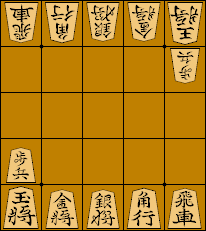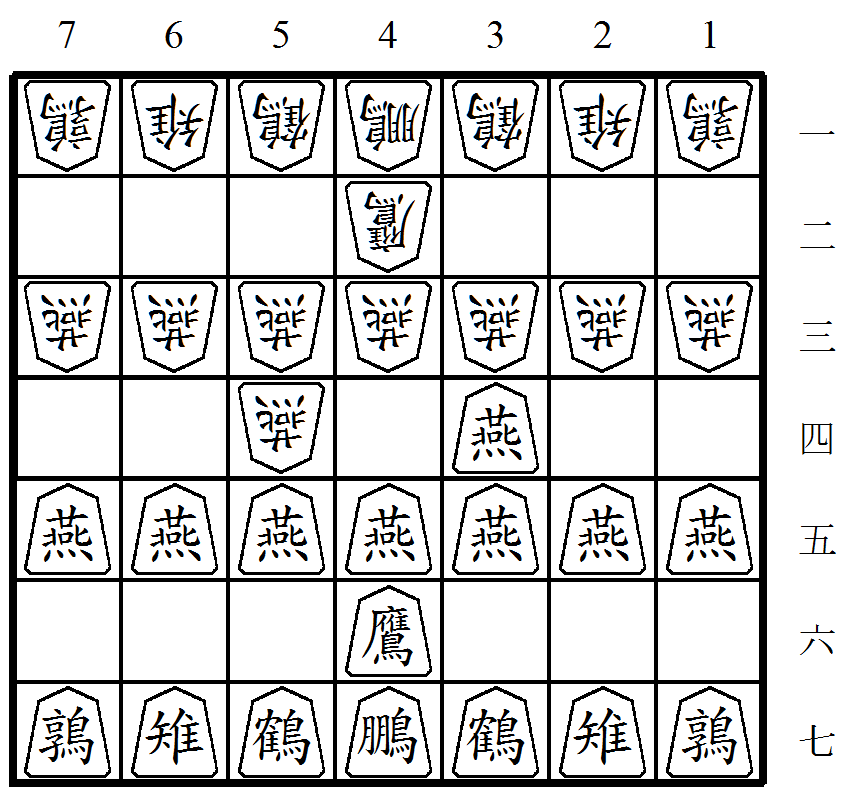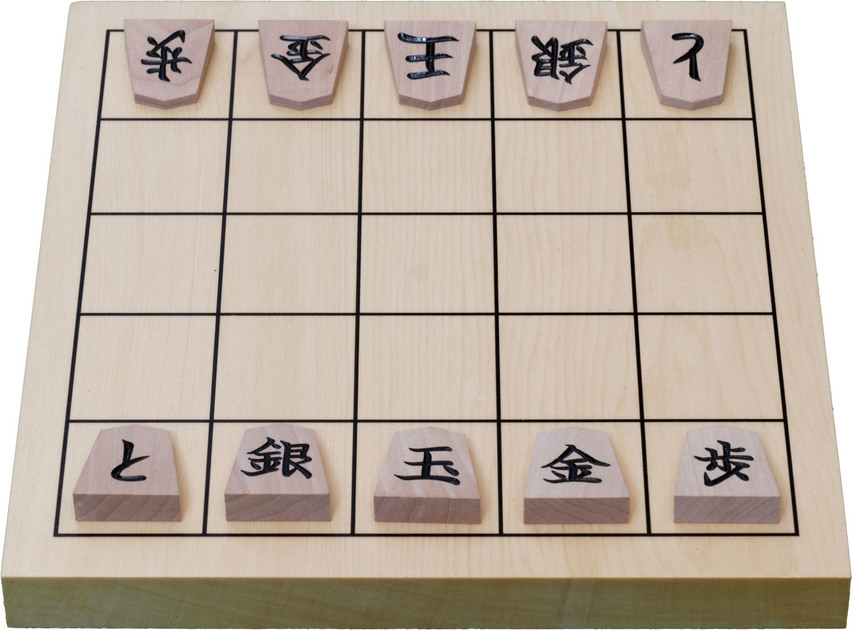|
Microshogi
Microshogi (五分摩訶将棋 ''gofun maka shōgi'' "5-minute (scarlet) poppy chess") is a modern variant of shogi (Japanese chess), with very different rules for promotion, and demotion. Kerry Handscomb of NOSTNOST (kNights of the Square Table), a (now defunct) correspondence game club formed in 1960 by Bob Lauzon and Jim France, enjoyed several hundred active members. gave it this English name. Although not confirmed, he credits its invention to the late Oyama Yasuharu, a top level shogi player. The game was invented before 1982. Equipment Two players play on a board ruled into a grid of 5 ranks (rows) by 4 files (columns). The squares are undifferentiated by marking or color. Each player has a set of 5 wedge-shaped pieces. The pieces are of slightly different sizes. From largest to smallest (or most to least powerful) they are: *1 king *1 bishop *1 gold general *1 silver general *1 pawn Game rules The game is identical to standard shogi with the following exceptions. Setu ... [...More Info...] [...Related Items...] OR: [Wikipedia] [Google] [Baidu] |
Minishogi
Minishogi (5五将棋 ''gogo shōgi'' "5V chess" or "5×5 chess") is a modern variant of shogi (Japanese chess). The game was invented (or rediscovered) around 1970 by Shigenobu Kusumoto of Osaka, Japan. The rules are nearly identical to those of standard shogi, with the exception that it is played on a 5x5 board with a reduced number of pieces, and each player's promotion zone consists only of the rank farthest from the player. Rules of the game Objective Like in standard shogi, each player aims to checkmate the opponent's king. Game equipment Two players play on a board ruled into a grid of five ranks (rows) by five files (columns). The squares are undifferentiated by marking or color. Each player begins with a set of 6 wedge-shaped pieces; these are: *1 king *1 rook *1 bishop *1 gold general *1 silver general *1 pawn Their movements are identical to those of their namesakes in standard shogi. Setup Each player places their pieces in the positions shown below, point ... [...More Info...] [...Related Items...] OR: [Wikipedia] [Google] [Baidu] |
Tori Shogi
Tori shōgi (禽将棋 or 鳥将棋, 'bird chess') is a variant of shogi (Japanese chess), which was invented by Toyota Genryu in 1799 despite being traditionally attributed to his master Ōhashi Sōei. It was first published in 1828 and again in 1833. The game is played on a 7×7 board and uses the drop rule; it is the only traditional shogi variant, possibly besides wa shogi, to do so. This is one of the more popular shogi variants. There were tournaments in London and Royston in the 1990s and early 2000s. Rules of the game Objective The objective of the game is to capture your opponent's phoenix. Game equipment Two players, Black and White (or 先手 ''sente'' and 後手 ''gote),'' play on a board ruled into a grid of 7 ''ranks'' (rows) by 7 ''files'' (columns). The squares are undifferentiated by marking or color. Each player has a set of 16 wedge-shaped pieces, of slightly different sizes. From largest to smallest (or most to least powerful) they are: * 1 phoenix * 1 f ... [...More Info...] [...Related Items...] OR: [Wikipedia] [Google] [Baidu] |
Judkins Shogi
Judkins shogi (ジャドケンス将棋 ''Jadokensu shōgi'' "Judkins chess") is a modern variant of shogi (Japanese chess), however it is not Japanese. Credit for its invention has been given to Paul Judkins of Norwich, UK, prior to April 1998. Rules of the game Objective The objective of the game is to capture your opponent's king. Game equipment Two players, Black and White (or 先手 ''sente'' and 後手 ''gote''), play on a board ruled into a grid of 6 ''ranks'' (rows) by 6 ''files'' (columns). The squares are undifferentiated by marking or color. Each player has a set of 7 wedge-shaped pieces, of slightly different sizes. From largest to smallest (most to least powerful) they are: * 1 king * 1 rook * 1 bishop * 1 gold general * 1 silver general * 1 knight * 1 pawn Most of the English-language names are chosen to correspond to rough equivalents in Western chess, rather than as translations of the Japanese names. Each piece has its name in the form of two kanji written ... [...More Info...] [...Related Items...] OR: [Wikipedia] [Google] [Baidu] |
Kyoto Shogi
is a modern variant of shogi (Japanese chess). It was invented by Tamiya Katsuya c. 1976. Kyoto shogi is played like standard shogi, but with a reduced number of pieces on a 5×5 board. However, the pieces alternately promote and demote with every move, and the promotion values are entirely different from standard shogi. Rules of the game Game equipment Two players play on a board ruled into a grid of 5 ''ranks'' (rows) by 5 ''files'' (columns). The squares are undifferentiated by marking or color. Each player has a set of 5 wedge-shaped pieces, of slightly different sizes. From largest to smallest (most to least powerful) they are: * 1 king * 1 gold general * 1 silver general * 1 tokin * 1 pawn The names of the pieces combine their promoted and unpromoted values, and are puns in Japanese for words with the same pronunciations but different kanji. For example, the lance/tokin is homonymous with the name of the city 京都 Kyoto, and provides the name of the game. Se ... [...More Info...] [...Related Items...] OR: [Wikipedia] [Google] [Baidu] |
Yari Shogi
Yari shogi (槍将棋 ''yari shōgi'', spear chess, where 'spear' is another name for the lance piece) is a modern variant of shogi (Japanese chess); however, it is not Japanese. It was invented in 1981 by Christian Freeling of the Netherlands. This game accentuates shogi’s intrinsically forward range of direction by giving most of the pieces the ability to move any number of free squares orthogonally forward like a shogi lance. The opposite is true of promoted pieces which can move backward with the same power. Rules of the game Objective The objective of the game is to capture your opponent's general. Game equipment Two players, Black and White (or 先手 ''sente'' and 後手 ''gote''), play on a board ruled into a grid of 9 ''ranks'' (rows) by 7 ''files'' (columns). The squares are undifferentiated by markings or color. Each player has a set of 14 wedge-shaped pieces, of slightly different sizes. From largest to smallest (most to least powerful) they are: * 1 general * 2 y ... [...More Info...] [...Related Items...] OR: [Wikipedia] [Google] [Baidu] |
Shogi Variant
A shogi variant is a game related to or derived from shogi (Japanese chess). Many shogi variants have been developed over the centuries, ranging from some of the largest chess-type games ever played to some of the smallest. A few of these variants are still regularly played, though none are as popular as shogi itself. The drop rule, often considered the most notable feature of shogi, is absent from most shogi variants, which therefore play more like other forms of chess, with the board becoming less crowded as pieces are exchanged. This is especially true for variants larger than shogi itself − in fact, the largest well-known variant that features the drop rule is the 11×11 game wa shogi. Predecessors of modern shogi Some form of chess had almost certainly reached Japan by the 9th century, if not earlier, but the earliest surviving Japanese description of the rules of chess dates from the early 12th century, during the Heian period. Unfortunately, this description does not ... [...More Info...] [...Related Items...] OR: [Wikipedia] [Google] [Baidu] |
Shogi
, also known as Japanese chess, is a strategy board game for two players. It is one of the most popular board games in Japan and is in the same family of games as Western chess, ''chaturanga, Xiangqi'', Indian chess, and '' janggi''. ''Shōgi'' means general's (''shō'' ) board game (''gi'' ). Western chess is sometimes called (''Seiyō Shōgi'' ) in Japan. Shogi was the earliest chess-related historical game to allow captured pieces to be returned to the board by the capturing player. This drop rule is speculated to have been invented in the 15th century and possibly connected to the practice of 15th century mercenaries switching loyalties when captured instead of being killed. The earliest predecessor of the game, chaturanga, originated in India in the sixth century, and the game was likely transmitted to Japan via China or Korea sometime after the Nara period."Shogi". ''Encyclopædia Britannica''. 2002. Shogi in its present form was played as early as the 16th century, while ... [...More Info...] [...Related Items...] OR: [Wikipedia] [Google] [Baidu] |
Correspondence Chess
Correspondence chess is chess played by various forms of long-distance correspondence, traditionally through the postal system. Today it is usually played through a correspondence chess server, a public internet chess forum, or email. Less common methods that have been employed include fax, homing pigeon and phone. It is in contrast to (OTB) chess, where the players sit at a chessboard at the same time, or play each other in real time via the internet. Correspondence chess allows people or clubs who are geographically distant to play one another without meeting in person. These distant relationships are just one of the many distinct appeals of correspondence chess. The length of a game played by correspondence can vary depending on the method used to transmit moves: a game played via server or by email might last no more than a few days, weeks, or months; a game played by post between players in different countries might last several years. Structure Correspondence chess diff ... [...More Info...] [...Related Items...] OR: [Wikipedia] [Google] [Baidu] |
Oyama Yasuharu
Oyama, Ōyama or Ohyama may refer to: * Oyama, Tochigi ( ja, 小山市, link=no), a city in Japan * Ōyama, Ōita ( ja, 大山町, link=no), a town in Japan * Oyama, Shizuoka ( ja, 小山町, link=no), a town in Japan * Mount Ōyama (Kanagawa) ( ja, 大山, link=no), a mountain in Japan * Oyama (Japanese theatre) ( ja, 女形, link=no), also known as ''onnagata'' ( ja, 女形/女方, link=no), a male actor who plays female parts in Kabuki * Oyama, British Columbia, a town in Lake Country, British Columbia, Canada People with the surname *Anza Ohyama (born 1976), Japanese singer and actress *Heiichiro Ohyama, Japanese conductor and violinist *Kana Oyama (born 1984) ( ja, 大山 加奈, link=no), Japanese volleyball player *Ōyama Iwao ( ja, 大山 巌, link=no), Japanese field marshal * Oyama Susumu (born 1952), Japanese sumo wrestler *Mas Oyama ( ja, 大山 倍達, link=no), karate master *, Japanese speed skater *, Japanese karateka *Shungo Oyama ( ja, 大山 峻護, link=no), Jap ... [...More Info...] [...Related Items...] OR: [Wikipedia] [Google] [Baidu] |
Cannon Shogi
A shogi variant is a game related to or derived from shogi (Japanese chess). Many shogi variants have been developed over the centuries, ranging from some of the largest chess-type games ever played to some of the smallest. A few of these variants are still regularly played, though none are as popular as shogi itself. The drop rule, often considered the most notable feature of shogi, is absent from most shogi variants, which therefore play more like other forms of chess, with the board becoming less crowded as pieces are exchanged. This is especially true for variants larger than shogi itself − in fact, the largest well-known variant that features the drop rule is the 11×11 game wa shogi. Predecessors of modern shogi Some form of chess had almost certainly reached Japan by the 9th century, if not earlier, but the earliest surviving Japanese description of the rules of chess dates from the early 12th century, during the Heian period. Unfortunately, this description does not ... [...More Info...] [...Related Items...] OR: [Wikipedia] [Google] [Baidu] |




.png)